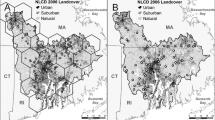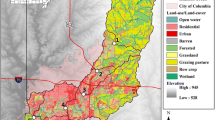Abstract
Meta-analyses reveal that nutrient yields tend to be higher for watersheds dominated by anthropogenic uses (e.g., urban, agriculture) and lower for watersheds dominated by natural vegetation. One implication of this pattern is that loss of natural vegetation will produce increases in watershed nutrient yields. Yet, the same meta-analyses also reveal that, absent land-cover change, watershed nutrient yields vary from one year to the next due to many exogenous factors. The interacting effects of land cover and exogenous factors suggest nutrient yields should be treated as distributions, and the effect of land-cover change should be examined by looking for significant changes in the distributions. We compiled nutrient yield distributions from published data. The published data included watersheds with homogeneous land cover that typically reported two or more years of annual nutrient yields for the same watershed. These data were used to construct statistical models, and the models were used to estimate changes in the nutrient yield distributions as a result of land-cover change. Land-cover changes were derived from the National Land Cover Database (NLCD). Total nitrogen (TN) yield distributions increased significantly for 35 of 1550 watersheds and decreased significantly for 51. Total phosphorus (TP) yield distributions increased significantly for 142 watersheds and decreased significantly for 17. The amount of land-cover change required to produce significant shifts in nutrient yield distributions was not constant. Small land-cover changes led to significant shifts in nutrient yield distributions when watersheds were dominated by natural vegetation, whereas much larger land-cover changes were needed to produce significant shifts when watersheds were dominated by urban or agriculture. We discuss our results in the context of the Clean Water Act.



Similar content being viewed by others
References
Alexander RB, Smith RA, Schwarz GE (2000) Effect of stream channel size on the delivery of nitrogen to the Gulf of Mexico. Nature 403:758–761
Alexander RB, Slack JR, Ludtke AS, Fitzgerald KK, Schertz TL (1998) Data from selected U.S. Geological Survey national stream water quality monitoring networks. Water Resources Research 34:2401–2405
Arnold JG, Srinivasan R, Muttiah RS, Williams JR (1998) Large-area hydrologic modeling and assessment: part I. model development. Journal of the American Water Resources Association 34:73–89
Clesceri NL, Curran SJ, Sedlak RI (1986) Nutrient loads to Wisconsin lakes: part I. Nitrogen and phosphorus export coefficients. Water Resources Bulletin 22:983–989
Beaulac MN, Reckhow KH (1982) An examination of land use – nutrient export relationships. Water Resources Bulletin 18:1013–1024
Dodds WK, Welch EB (2000) Establishing nutrient criteria in streams. 2000. Journal of the North American Benthological Society 19:186–196
Dodds WK, Oakes RM (2004) A technique for establishing reference nutrient concentrations across watersheds effected by humans. Limnology and Oceanography: methods 2:333–341
Dodds WK, Blair JM, Hennebry GM, Koelliker JK, Ramundo R, Tate CM (1996) Nitrogen transport from tallgrass prairie watersheds. Journal of Envirionmental Quality 25:973–981
Donigian AS Jr, Imhoff JC (2002) From the Stanford Model to BASINS: 40 years of watershed modeling. ASCE Task Committee on Evolution of hydrologic Methods Through Computers. ASCE 150th Anniversary Celebration, November 3–7, 2002, Washington, DC. Available at: http://www.hspf.com/publications.html. Last viewed March 13, 2008
Fegeas RG, Claire RW, Guptil SC, Anderson KE, Hallam CA (1983) Land use and land cover digital data. Geological Survey Circular 895-E, U.S. Geological Survey, Washington, DC
Fisher TR, Lee KY, Berndt H, Benitez JA, Norton MM (1998) Hydrology and chemistry of the Choptank river basin. Water, Air, and Soil Pollution 105:387–397
FGDC (Federal Geographic Data Committee) (2004) Federal standards for delineation of hydrologic unit boundaries; Version 2. Available at: http://www.ncgc.nrcs.usda.gov/products/datasets/watershed/. Last viewed March 13, 2008
Frink CR (1991) Estimating nutrient exports to estuaries. Journal of Environmental Quality 20:717–724
Gassman PW, Reyes MR, Green CH, Arnold JG (2007) The soil and water assessment tool: historical development, applications, and future research directions. Transactions of the American Society of Agricultural and Biological Engineers 504:1211–1250
Gesch D, Oimen D, Greenlee S, Nelson C, Steuck M, Tyler D (2002) The National Elevation Dataset. Photogrammetric Engineering and Remote Sensing 68:5–11
Groffman PM, Law NL, Belt KT, Band LE, Fisher GT (2004) Nitrogen fluxes and retention in urban watershed ecosystems. Ecosystems 7:393–403
Homer C, Dewitz J, Fry J, Coan M, Hossain N, Larson C, Herold N, McKerrow A, VanDriel JN, Wickham JD (2007) Completion of the 2001 National Land Cover Database for the conterminous United States. Photogrammetric Engineering & Remote Sensing 73:337–341
Howarth RW, Billen G, Swaney D, Townsend A, Jaworski N, Lajtha K, Dowling JA, Elmgren R, Caraco N, Jordan T, Berendse F, Freney J, Kudeyarov V, Murdoch P, Zhao-Liang Z (1996) Regional nitrogen budgets and riverine N & P fluxes for the drainages of the North Atlantic Ocean: natural and human influences. Biogeochemistry 35:75–139
Hunsaker CT, Levine DA (1995) Hierarchical approaches to the study of water quality in rivers. BioScience 45:193–203
Jones KB, Neale AC, Nash MS, Van Remortel RD, Wickham JD, Riitters KH, O’Neill RV (2001) Predicting nutrient and sediment loadings to streams from landscape metrics: a multiple watershed study from the United States mid-Atlantic Region. Landscape Ecology 16:301–312
Jordan TE, Correll DL, Weller DE (1997) Effects of agriculture on discharges of nutrients from Coastal Plain watersheds of Chesapeake Bay. Journal of Environmental Quality 26:836–848
Kemp MJ, Dodds WK (2001) Spatial and temporal patterns of nitrogen concentrations in pristine and agriculturally-influenced prairie streams. Biogeochemistry 53:125–141
Lewis WM Jr (2002) Yield of nitrogen from minimally disturbed watersheds in the United States. Biogeochemistry 57/58:375–385
Line DE, White NM, Osmond DL, Jennings GD, Mojonnier CB (2002) Pollutant export from various land uses in the upper Neuse River basin. Water Environment Research 74:100–108
Linker LC, Stigall GC, Chang CH, Donigian AS (1996) Aquatic accounting: Chesapeake Bay watershed model quantifies nutrient loads. Water Environment and Technology 8:48–52
McFarland AMS, Hauck LM (2001) Determining nutrient export coefficients and source loading uncertainty using in-stream monitoring data. Journal of the American Water Resources Association 37:223–236
McMahon G, Alexander RB, Qian S (2003) Support of total maximum daily load program using spatially referenced regression models. Journal of Water Resources Planning and Management 129:315–328
Meybeck J (1982) Carbon, nitrogen, and phosphorus transport by world rivers. American Journal of Science 282:401–450
Omernik JM (1977) Nonpoint source-stream nutrient level relationships: a nationwide study. EPA-600/3-77-105. Office of Research and Development, U.S. Environmental Protection Agency, Corvallis, OR, USA
Osborne LL, Kovacic DA (1993) Riparian vegetated buffer strips in water-quality restoration and stream management. Freshwater Biology 52:243–258
Panuska JC, and Lillie RA (1995) Phosphorus loadings from Wisconsin watersheds: recommended phosphorus export coefficients for agricultural and forested watersheds. Research Management Findings, Number 38, Bureau of Research, Wisconsin Department of Natural Resources, Madison, Wisconsin, USA, 8 pp
Paul MJ, Meyer JL (2001) Streams in the urban landscape. Annual Review of Ecology and Systematics 32:333–365
Peterjohn WT, Correll DL (1984) Nutrient dynamics in an agricultural watershed: observations on the role of a riparian forest. Ecology 65:1466–1475
Rabalais NN, Turner RE, Justić D, Dortch Q, Wiseman WJ Jr, Sen Gupta BK (1996) Nutrient changes in the Mississippi River and system responses on the adjacent Continental Shelf. Estuaries 19:386–407
Reckhow KH, Beaulac MN, Simpson JT (1980) Modeling phosphorus loading and lake response under uncertainty: a manual and compilation of export coefficients. EPA/440/5-80/011, U.S. Environmental Protection Agency, Washington, DC, USA
Rohm CM, Omernik JM, Woods AJ, Stoddard JL (2002) Regional characteristics of nutrient concentrations in streams and their application to nutrient criteria development. Journal of the American Water Resources Association 38:213–239
Shenk G, Linker L. Unpubl. Simulating the Chesapeake Bay Watershed with time-varying land use and management actions. Available at: http://www.chesapeakebay.net/pubs/subcommittee/mdsc/doc-Shenk_timevaryinglanduse431.pdf. Last viewed April 23, 2008
Smith RA, Alexander RB, Schwarz GE (2003) Natural background concentrations of nutrients in streams and rivers of the conterminous United States. Environmental Science and Technology 37:3039–3047
Smith RA, Schwarz GE, Alexander RB (1997) Regional interpretation of water-quality monitoring data. Water Resources Research 33:2781–2798
USEPA (U.S. Environmental Protection Agency) (1997) Hydrological Simulation Program – FORTRAN: User’s Manual for Version 11. EPA/600/SR-97/080. Office of Research and Development, Environmental Protection Agency, Research Triangle Park, NC, USA
USEPA (U.S. Environmental Protection Agency) (1998) National strategy for the development of regional nutrient criteria. EPA 822-R-98-002. Office of Water, U.S. Environmental Protection Agency, Washington, DC, USA
USGS (U.S. Geological Survey) (1996) Data from selected U.S. Geological Survey National Stream Water-Quality Monitoring Networks (WQN). U.S. Geological Survey Digital Data Series DDS-37, ISBN 0-607-86425-7
Vogelmann JE, Howard SM, Yang L, Larson CR, Wylie BK, Van Driel N (2001) Completion of the 1990s National Land Cover Data Set for the Conterminous United States from Landsat Thematic Mapper data and ancillary data sources. Photogrammetric Engineering and Remote Sensing 67:650–662
Vuorenmaa J, Recolainen S, Lepistö A, Kenttämies K, Kauppila P (2002) Losses of nitrogen and phosphorus from agricultural and forest areas in Finland during the 1980s and 1990s. Environmental Monitoring and Assessment 76:213–248
Waring RH, Schlesinger WH (1985) Forest ecosystems: concepts and management. Academic Press, Orlando, FL, USA
Wickham JD, Riitters KH, O’Neill RV, Reckhow KH, Wade TG, Jones KB (2000) Land cover as a framework for assessing risk of water pollution. Journal of the American Water Resources Association 36:1417–1414
Wickham JD, O’Neill RV, Riitters KH, Smith ER, Wade TG, Jones KB (2002) Geographic targeting of increases in nutrient export due to future urbanization. Ecological Applications 12:93–106
Wickham JD, Riitters KH, Wade TG, Jones KB (2005) Evaluating the relative roles of ecological regions and land-cover composition for guiding establishment of nutrient criteria. Landscape Ecology 20:791–798
Acknowledgments
The U.S. Environmental Protection Agency (EPA), through its Office of Research and Development (ORD), funded the research. This article has been subjected to the EPA’s peer and administrative review and has been approved for publication. Kurt Riitter’s participation was supported by the U.S. Forest Service and the Center for Landscape Pattern Analysis. The authors thank Lisa Smith, Steve Verrill, Walter Dodds, Larry Band, and two anonymous reviewers for their helpful comments on previous versions of the paper.
Author information
Authors and Affiliations
Corresponding author
Rights and permissions
About this article
Cite this article
Wickham, J.D., Wade, T.G. & Riitters, K.H. Detecting Temporal Change in Watershed Nutrient Yields. Environmental Management 42, 223–231 (2008). https://doi.org/10.1007/s00267-008-9120-8
Received:
Revised:
Accepted:
Published:
Issue Date:
DOI: https://doi.org/10.1007/s00267-008-9120-8




